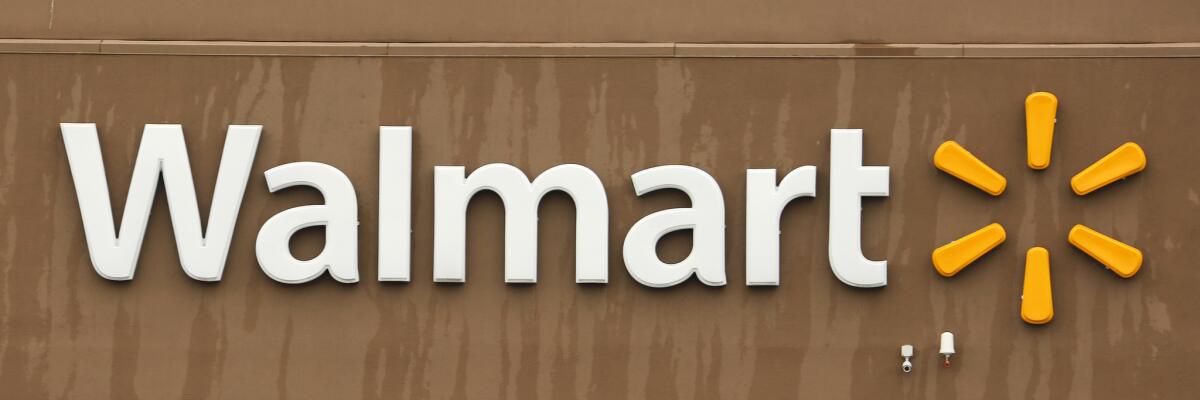Walmart’s answer to Amazon Prime has deep, hidden roots

- Share via
The imminent introduction of Walmart Inc.’s new subscription program took investors by surprise this week, sending the retailer’s shares up the most in almost four months.
Although details of the program, dubbed Walmart+, are still hazy, the service is rooted in three experiments the world’s biggest retailer has conducted in recent years to gauge the willingness of its shoppers to deepen their allegiance. The trials span the globe and include mobile checkout, unlimited grocery delivery and a social media-based mini-app in China.
Although not always resounding successes, the pilot programs taught the company valuable lessons and gave it the confidence to roll out Walmart+, which could offer a variety of services, including free same-day delivery and virtual entertainment for kids.
Walmart+ arrives as the retailer picks up millions of new customers during the pandemic — a result of low prices on food and essentials, a ubiquitous store network and improvements to online shopping. Rival Amazon.com Inc., meanwhile, suffered from some high-profile delays early on in getting stuff to customers.
Shopping trends
Amid lingering economic lockdowns, virus-leery consumers are consolidating their shopping trips and spending larger sums at fewer retailers. This benefits mass merchants such as Walmart and Target Corp., which sell beer, broccoli, baseball bats, office supplies and many other products.
Holding on to those converts is essential for Walmart right now, and the “stickiness” of a membership program with speedy delivery and other perks might just be the way to keep them in the fold. Five million customers could join Walmart+ off the bat, according to a survey from Credit Suisse analysts and researcher Numerator, and the potential audience could be as large as 20 million.
Even for a company as large as Walmart, with about 160 million weekly visits to its U.S. stores and website, that’s a big number. Amazon’s Prime program, by contrast, has more than 118 million members in the U.S., according to Consumer Intelligence Research Partners.
‘An opportune time’
“At a time when consumers are consolidating purchases, this seems like an opportune time to roll out this offering,” Credit Suisse analyst Seth Sigman said in a note. “We see it as a way to retain incremental customers, create a higher level of stickiness, as well as attract new customers to its wider offering. Walmart+ could be a key driver to pull it all together.”
Walmart+ surprised many when its existence leaked out in February, but the retailer has been laying down the service’s foundations for several years now. A key building block is Scan & Go, a mobile-checkout system that enables shoppers to ring up purchases on a smartphone app and skip the lines at the cashier.
Walmart started testing the service in its U.S. stores back in 2012. It found the most adoption in its Sam’s Club warehouse division, which carries a much smaller assortment of products that are all bar-coded, eliminating the hassle of scanning a handpicked bag of apples, for instance.
Walmart quietly shut down Scan & Go in its namesake stores in 2018 but will probably bring it back exclusively for members of Walmart+. Enhancements such as computer vision and machine learning have made Scan & Go faster and easier to use, reducing the time required to scan an item to about three seconds, down from nine previously.
Another element of Walmart+ came from China, where the retailer rolled out a service in 2017 over WeChat, the wildly popular messaging service owned by Tencent Holdings Ltd. that connects more than 1 billion people.
Walmart developed a so-called Mini Program, an external app that sits on top of WeChat, which in this case included Scan & Go and another function that guided consumers through the store based on their shopping list. The program, which also facilitated same-day deliveries, was a huge hit, attracting more than 10 million monthly active users in less than a year.
Another element was unearthed closer to home in the form of Walmart’s Delivery Unlimited program, which launched last year. Shoppers paid $98 a year, or $12.95 monthly, for the home delivery service, which was expanded from a few cities to 1,400 stores late last year. Although not as popular as Walmart’s curbside pickup service, home delivery has found new adherents during the pandemic with shoppers more likely to be home all day, eliminating the hassle of finding the right delivery window.
Crucial data
The personalized nature of the three services illustrates Walmart’s eagerness to gather more data about its customers. It can use the information to tailor its prices and product assortment, while also packaging and selling it to big consumer product brands for targeted digital ads. Having watched Amazon build a massive advertising business, Walmart now is looking to do the same, leveraging the long-standing relationships it has with major advertisers such as Procter & Gamble Co. and Coca-Cola Co.
Walmart has never had a loyalty club like most retailers do — founder Sam Walton wanted to treat every customer the same — but the growing prevalence of digital shopping, and the growing threat of Amazon to its grocery business, has forced it to rethink its relationship with consumers.
“By not having a loyalty program, Walmart has had a data deficit to other retailers and e-commerce operators,” said Jordan Berke, who spent 14 years with Walmart and helped lead its Chinese digital operations before departing last year to start Tomorrow Retail Consulting. “This is a big step toward getting more personalized.”
More to Read
Inside the business of entertainment
The Wide Shot brings you news, analysis and insights on everything from streaming wars to production — and what it all means for the future.
You may occasionally receive promotional content from the Los Angeles Times.










